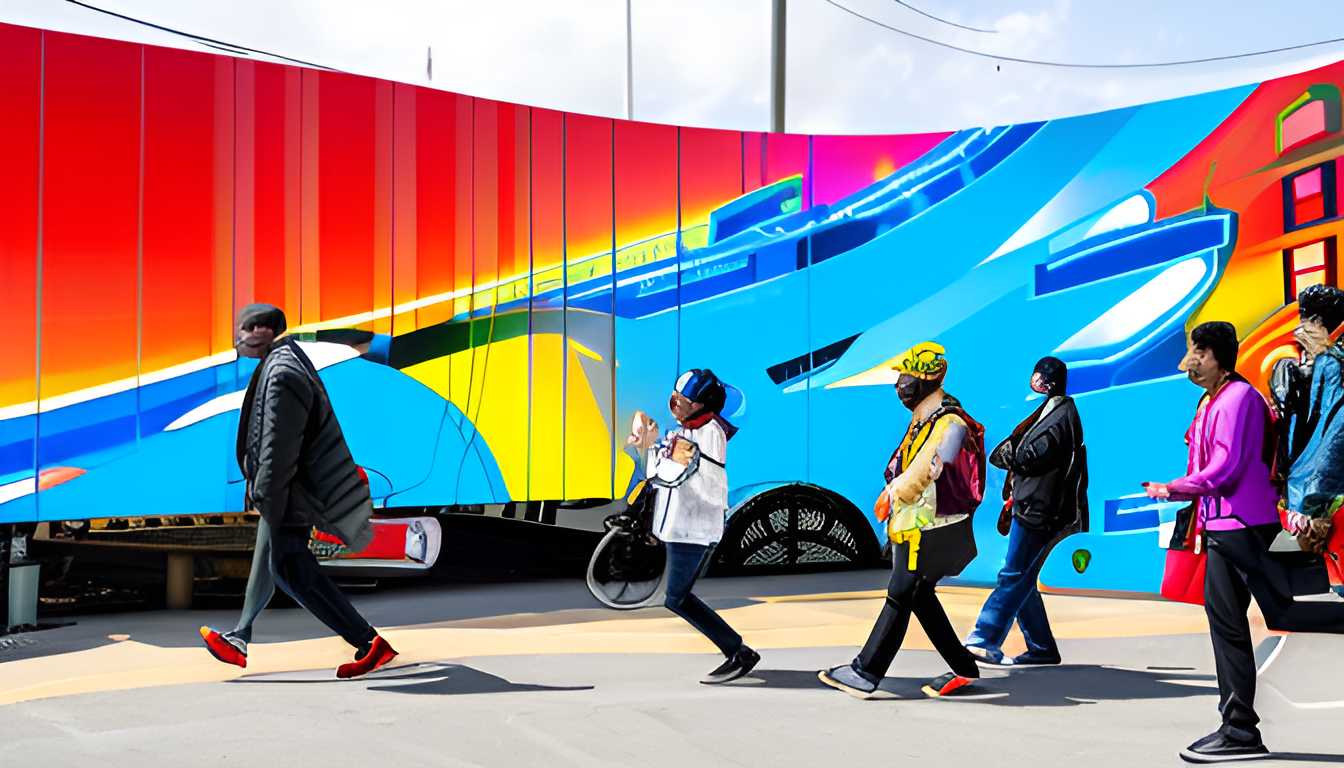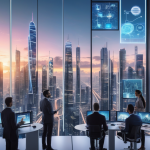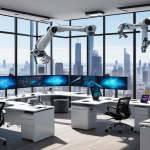How AI Is Influencing Social Structures and Norms

The advent of artificial intelligence (AI) has ushered in a new era that is profoundly reshaping our societal frameworks and interpersonal relationships. Imagine a world where machines not only assist us but also influence the very fabric of our daily lives—this is the reality we are stepping into. AI is not just a tool; it’s a transformative force that is redefining how we interact, work, and even think. As we delve into the nuances of this impact, it becomes clear that the implications are as complex as they are significant.
One of the most striking ways AI is influencing social structures is through communication. Consider the way we connect with others today. From chatbots that provide instant customer service to sophisticated algorithms that curate our social media feeds, AI is changing the dynamics of human interaction. It’s almost like having a personal assistant who knows your preferences and influences your choices, but this can lead to both positive and negative outcomes. For instance, while AI can enhance connectivity, it can also create barriers by filtering out diverse perspectives, leading to a more homogenous social experience.
Moreover, the impact of AI extends into the workplace, where it is revolutionizing employment trends. As automation takes over routine tasks, many traditional roles are becoming obsolete. This shift raises crucial questions about economic stability and the future of work. Are we prepared for the changes that lie ahead? The answer is not straightforward. While some jobs may disappear, new opportunities are emerging that require a different set of skills. This duality presents a challenge and an opportunity, emphasizing the need for effective reskilling initiatives to help workers navigate this evolving landscape.
AI’s influence also permeates cultural norms, challenging our established values and expectations. For example, as we increasingly rely on AI for personal relationships—think dating apps and virtual companions—we must confront the implications for authenticity and emotional connection. Are we sacrificing genuine human interaction for convenience? Additionally, as AI technologies gather vast amounts of personal data, societal norms around privacy are shifting dramatically, igniting debates about consent and surveillance that are more relevant than ever.
In conclusion, the influence of AI on social structures and norms is profound and multifaceted. As we embrace this technological advancement, it is essential to remain vigilant about its implications, ensuring that we foster a society that values diversity, authenticity, and individual autonomy.
The Role of AI in Communication
Artificial Intelligence is dramatically reshaping the way we communicate, and it’s hard to overstate its impact. Imagine a world where your conversations are facilitated by intelligent systems that understand context, tone, and even emotions. This is not just a futuristic dream; it’s happening right now! From chatbots that provide instant customer service to sophisticated algorithms that curate our social media feeds, AI is influencing every aspect of our interactions.
One of the most significant changes is how we consume information. AI algorithms analyze our preferences and behavior, tailoring content to fit our interests. This personalization can be incredibly beneficial, making it easier to find relevant information. However, it also raises questions about the echo chambers that can form when we are only exposed to viewpoints that align with our own. Are we truly engaging with diverse perspectives, or are we trapped in a bubble?
Moreover, AI is transforming interpersonal communication. Have you ever noticed how your messaging apps suggest replies based on the conversation? This feature, powered by AI, can make communication faster and more efficient. But does it also dilute the authenticity of our conversations? It’s a double-edged sword, creating convenience while potentially sacrificing the depth of human interaction.
In professional settings, AI tools are changing the landscape of collaboration. Virtual assistants can schedule meetings, manage tasks, and even analyze team dynamics, allowing for smoother workflows. Yet, as we rely more on these technologies, we must consider the implications for team cohesion and interpersonal relationships. Are we becoming too dependent on AI to mediate our interactions?
In conclusion, the role of AI in communication is multifaceted, offering both exciting opportunities and significant challenges. As we navigate this evolving landscape, it’s essential to remain aware of how these technologies shape our relationships and the information we consume. Balancing the benefits of AI with the need for genuine human connection is crucial for fostering a healthy communication environment.
AI and Employment Trends
Artificial Intelligence is revolutionizing the workplace, and its impact on employment trends is nothing short of astonishing. As AI technologies become more integrated into various industries, we’re witnessing a transformation that is reshaping job markets and altering the very fabric of work. Imagine walking into an office where robots handle mundane tasks, freeing up humans to engage in more creative and strategic roles. Sounds futuristic, right? Yet, this is the reality we are stepping into.
However, with great change comes great concern. While AI creates new opportunities, it also renders some roles obsolete. For instance, jobs that involve repetitive tasks, like data entry or assembly line work, are increasingly being taken over by machines. This shift raises significant questions about economic stability and the future of work. Will there be enough jobs left for humans? How can we prepare ourselves for this new landscape?
To address these challenges, many organizations are implementing reskilling initiatives. These programs aim to equip workers with the necessary skills to thrive in an AI-driven environment. For example, a factory worker might learn how to operate and maintain advanced robotics, ensuring they remain valuable in their field. Companies are beginning to realize that investing in their employees’ growth is crucial for long-term success.
Moreover, while some jobs are lost to automation, AI is also expected to create entirely new job categories. Think about roles that didn’t exist a decade ago, like data scientists or AI ethicists. These emerging positions will require a shift in educational focus, emphasizing STEM and critical thinking skills. Preparing future generations for these roles is essential to ensure they can navigate the evolving job market.
In summary, AI’s influence on employment trends is profound, presenting both challenges and opportunities. As we adapt to this new reality, it’s crucial for individuals, companies, and educational institutions to collaborate and embrace the changes ahead.
Automation and Job Displacement
The rise of automation powered by artificial intelligence is reshaping the job market in ways we never imagined. As industries embrace AI technologies, the fear of job displacement looms large. It’s like watching a skilled magician pull a rabbit out of a hat—except in this case, the rabbit is a job, and it’s disappearing right before our eyes. Many workers are left feeling anxious about their futures, as roles that were once stable and secure are now at risk of becoming obsolete.
Industries such as manufacturing, retail, and even healthcare are experiencing significant transformations. For example, robots are now capable of performing tasks that once required human hands, from assembling products to managing inventory. This shift not only increases efficiency but also raises questions about the sustainability of traditional employment. According to recent studies, an estimated 20% to 30% of jobs could be automated in the next decade, impacting millions of workers worldwide.
While the prospect of job loss is daunting, it’s essential to recognize that automation can also lead to the creation of new roles that require different skill sets. Workers may need to pivot and adapt, much like a dancer adjusting their routine to a new rhythm. This is where reskilling initiatives come into play, providing opportunities for individuals to learn new skills that align with the demands of an AI-driven job market.
Companies are beginning to understand the importance of investing in their workforce. Many are implementing training programs aimed at equipping employees with the skills necessary to thrive in a changing landscape. This proactive approach not only helps mitigate the effects of job displacement but also fosters a culture of innovation and adaptability. As we navigate this transition, it’s crucial to foster an environment where workers feel supported and empowered to embrace change.
In conclusion, while automation and job displacement present significant challenges, they also offer a chance for growth and evolution in the workforce. The key lies in our ability to adapt, reskill, and redefine our roles in this new era. After all, change is the only constant, and how we respond to it will shape our future.
Reskilling Initiatives
The rapid evolution of technology, particularly through artificial intelligence (AI), has created a pressing need for . As job roles transform and new industries emerge, workers must adapt to stay relevant in the workforce. This transition is not just about learning new skills; it’s about rethinking how we approach our careers in an AI-driven world.
Many organizations are recognizing the urgency of this situation. They are investing in training programs that focus on upskilling employees to handle advanced technologies. These programs often include:
- Workshops and Seminars: Interactive sessions that provide hands-on experience with new tools and methodologies.
- Online Courses: Flexible learning options that allow employees to learn at their own pace, covering topics like data analysis, machine learning, and digital marketing.
- Mentorship Programs: Pairing experienced professionals with those looking to gain new skills, fostering a culture of knowledge sharing.
Moreover, the role of educational institutions is critical in this landscape. Universities and vocational schools are updating their curricula to include AI-related courses, ensuring that graduates are equipped with the necessary skills to thrive. Collaboration between businesses and educational bodies can lead to tailored training programs that meet industry demands, thus creating a more agile workforce.
In addition to formal education, self-directed learning has become increasingly important. Many individuals are turning to online platforms like Coursera and Udacity to gain insights into AI and its applications. This shift towards continuous learning reflects a broader cultural change: the understanding that adaptability is key in today’s job market.
As we look to the future, it’s clear that reskilling initiatives are not just a trend; they are a necessity. By embracing new learning opportunities and fostering a culture of growth, we can ensure that the workforce is prepared to meet the challenges of an AI-driven economy.
Future Job Creation
The landscape of employment is rapidly evolving, and with the rise of artificial intelligence, we are witnessing a remarkable transformation in job creation. While it’s easy to focus on the jobs that AI might eliminate, it’s equally important to recognize the new opportunities that are emerging. Think of AI as a double-edged sword; it cuts away the old but also carves out new paths for innovation and employment.
As industries adapt to AI technologies, we can expect a surge in demand for roles that require a blend of technical skills and human creativity. For instance, positions in data analysis, machine learning engineering, and AI ethics are becoming increasingly vital. These roles not only require specialized knowledge but also a deep understanding of human behavior and societal impacts. In fact, a recent study indicated that by 2030, AI could create approximately 133 million new jobs globally while displacing around 75 million.
To illustrate this shift, consider the following table showcasing potential future job categories influenced by AI:
| Job Category | Description |
|---|---|
| AI Ethics Consultant | Advises companies on ethical AI practices and the societal implications of AI technologies. |
| Data Curator | Responsible for managing and organizing data sets to ensure accuracy and relevance for AI training. |
| Automation Specialist | Focuses on implementing and managing automated systems in various industries. |
| AI-Assisted Healthcare Professional | Utilizes AI tools to enhance patient care and streamline healthcare processes. |
Moreover, educational institutions are recognizing the need to adapt their curricula to prepare students for these emerging roles. Programs focusing on STEM education, along with soft skills like critical thinking and emotional intelligence, will be essential in equipping the future workforce. As we embrace this change, the collaboration between educational institutions, businesses, and governments will be crucial to ensure that workers are not left behind in this AI-driven economy.
In conclusion, while the fear of job loss due to AI is prevalent, the reality is that we are on the brink of a new era filled with opportunities. By fostering a culture of learning and adaptability, we can harness the potential of AI to create a brighter future for all.
AI in Decision-Making
Artificial Intelligence (AI) is rapidly becoming a crucial player in the decision-making landscape, influencing everything from our daily choices to corporate strategies. Imagine having a digital assistant that not only helps you with your tasks but also analyzes data to suggest the best course of action. Sounds futuristic, right? Well, it’s happening now! However, this shift brings with it a host of ethical questions that we must grapple with.
One of the most significant concerns is accountability. When an AI system makes a recommendation or a decision, who is responsible if things go awry? This dilemma is akin to having a self-driving car that makes a split-second decision in an emergency. Is it the programmer, the manufacturer, or the user who bears the blame? As AI systems become more autonomous, clarifying these lines of responsibility is crucial.
Transparency is another critical issue. Many AI algorithms operate as “black boxes,” meaning their decision-making processes are not easily understood by humans. This lack of clarity can lead to mistrust, as people may feel uncomfortable relying on systems they don’t fully understand. To illustrate, consider a hiring algorithm that favors certain candidates over others. If the criteria are hidden, how can we ensure fairness in the selection process?
Moreover, the influence of AI on our personal lives is profound. From recommending what to watch on streaming platforms to suggesting products based on our browsing history, the decisions made by AI can shape our preferences and behaviors. This raises the question: are we losing our autonomy in decision-making? Are we merely following the paths laid out by algorithms?
In summary, while AI brings efficiency and enhanced decision-making capabilities, it also introduces complex ethical dilemmas that we must navigate carefully. As we continue to integrate AI into various aspects of our lives, it’s essential to foster a dialogue about its implications, ensuring that we harness its potential responsibly.
Social Media Algorithms and Influence
In today’s digital landscape, social media algorithms play a pivotal role in shaping our online experiences. These algorithms determine what content we see, how we engage with others, and even influence our opinions. Imagine walking into a bookstore where the shelves are curated just for you—this is how social media operates, tailoring feeds to match your interests and behaviors. While this personalization can enhance user experience, it also raises significant concerns about the diversity of perspectives we encounter.
The algorithms work tirelessly behind the scenes, analyzing our interactions to predict what we will find engaging. However, this can lead to the creation of echo chambers. In these digital spaces, users are predominantly exposed to information that aligns with their existing beliefs, effectively isolating them from contrasting viewpoints. This phenomenon can deepen societal polarization, as individuals become less inclined to engage in constructive dialogue with those who hold different opinions.
Moreover, the influence of social media algorithms extends beyond mere content curation; they also dictate the trending topics and narratives that dominate public discourse. For instance, a viral post can ignite discussions on critical issues, but it can also skew perceptions based on the limited range of content that is promoted. It’s essential to recognize that while these algorithms can foster community and connection, they also have the potential to distort reality and reinforce biases.
To combat the negative effects of algorithm-driven echo chambers, some platforms are exploring ways to diversify content exposure. By tweaking their algorithms, they aim to present users with a broader array of viewpoints, encouraging a more balanced discourse. This shift not only promotes understanding across different perspectives but also enriches the overall social media experience.
In conclusion, while social media algorithms are powerful tools that shape our online interactions, it’s crucial to remain aware of their implications. As users, we must actively seek out diverse content and engage with differing opinions to foster a more inclusive and informed digital society.
Echo Chambers and Polarization
In today’s digital landscape, echo chambers have become a significant concern, particularly as AI algorithms dictate the content we consume on social media platforms. These algorithms are designed to enhance user engagement, which often leads to a cycle of reinforcing existing beliefs rather than challenging them. As a result, individuals are frequently surrounded by information that aligns with their pre-existing views, creating a bubble where dissenting opinions are scarce. This phenomenon can have profound effects on societal polarization, as people become more entrenched in their beliefs and less open to dialogue.
Imagine walking into a room where everyone shares your opinions and ideas. It feels comfortable, right? But what happens when you never hear the other side? This is precisely what echo chambers do—they create an environment where individuals are shielded from differing perspectives. The implications of this are vast, as it can lead to increased division within communities and even among friends and family. When discussions become less about understanding and more about defending one’s stance, the potential for constructive dialogue diminishes.
Moreover, the impact of echo chambers extends beyond individual beliefs; it can shape public discourse and influence major societal issues. For instance, consider the following:
- Political Polarization: Individuals may become more extreme in their political views, leading to a divided electorate.
- Social Movements: Movements can gain momentum within echo chambers, but may struggle to connect with broader audiences.
- Public Health: Misinformation can spread rapidly, as people only engage with like-minded individuals, impacting community health decisions.
Addressing the challenges posed by echo chambers requires a conscious effort to diversify our information sources. By actively seeking out different viewpoints and engaging in conversations with those who think differently, we can begin to break down the walls of polarization. In this interconnected world, fostering understanding and empathy is crucial to bridging divides and promoting a healthier discourse.
Diversity in Content Exposure
In today’s digital landscape, is more crucial than ever. As AI algorithms curate what we see on social media and other platforms, they have the power to either broaden our horizons or confine us to narrow viewpoints. Imagine walking into a library where every book is about the same topic; it would limit your understanding of the world. Similarly, when algorithms only show us content that aligns with our existing beliefs, we risk living in a bubble, disconnected from diverse perspectives.
To combat this, many platforms are beginning to recognize the importance of algorithm adjustments that promote a wider array of content. This shift is not just about increasing engagement; it’s about fostering a more informed society. When users are exposed to a variety of viewpoints, it can lead to healthier discussions and a more nuanced understanding of complex issues. For instance, consider the following benefits of diverse content exposure:
- Enhanced Critical Thinking: Encountering differing opinions encourages users to critically evaluate their own beliefs.
- Greater Empathy: Understanding perspectives that differ from our own can cultivate empathy and reduce polarization.
- Informed Decision-Making: A broad range of information helps individuals make well-rounded decisions in their personal and professional lives.
Platforms that actively promote diversity in content are not only enhancing user experience but are also playing a pivotal role in shaping societal norms. By prioritizing a mix of viewpoints, they can help dismantle echo chambers that often lead to misinformation and division. As we continue to navigate this AI-driven world, the responsibility lies with both technology creators and users to advocate for a more inclusive digital space. After all, a well-rounded perspective is the key to a healthier discourse and a more cohesive society.

AI and Cultural Norms
Artificial Intelligence is not just a technological marvel; it’s a cultural game-changer. As AI technologies like chatbots, recommendation systems, and virtual assistants become embedded in our daily lives, they are reshaping cultural norms in ways we never anticipated. Imagine a world where your preferences are predicted before you even express them—sounds like science fiction, right? But it’s happening now, and it’s altering our behaviors and expectations.
One of the most fascinating impacts of AI is its ability to influence trends. From fashion to music, AI algorithms analyze vast amounts of data to identify emerging patterns. This means that what you see trending today may have been curated by an algorithm that understands collective tastes. However, this can lead to the homogenization of culture, where unique local expressions are overshadowed by global trends dictated by AI.
Moreover, AI is redefining how we interact with one another. Consider dating apps powered by AI, which use algorithms to match people based on compatibility. While this can increase the chances of finding a suitable partner, it also raises questions about the authenticity of connections. Are we falling in love with algorithms rather than people? This dilemma highlights the ongoing struggle between technology and genuine human interaction.
As we embrace AI in our lives, we also face challenges regarding privacy. With AI systems collecting massive amounts of personal data, societal norms around privacy are rapidly evolving. People are now forced to reconsider what it means to share personal information. The line between convenience and surveillance is becoming increasingly blurred, prompting discussions about consent and the ethical implications of data collection.
In summary, AI is not merely a tool; it is a powerful force that is reshaping our cultural landscape. As we navigate this new reality, it’s crucial to reflect on how these changes affect our values, relationships, and sense of self. The question remains: Are we shaping AI, or is AI shaping us?
Impact on Relationships
The integration of AI into our daily lives is reshaping the very fabric of personal relationships. From dating apps powered by algorithms to virtual companions that provide emotional support, technology is influencing how we connect with others. Imagine swiping right on an app and finding your ideal match based on a complex algorithm that evaluates compatibility. It’s like having a personal matchmaker, but does it truly replace the magic of human connection?
While these innovations offer convenience, they also raise important questions about authenticity and emotional bonds. Are we forming genuine connections, or are we merely engaging with sophisticated programs designed to mimic human interaction? The reliance on AI can sometimes lead to a superficial understanding of relationships, where interactions are driven more by data than by feelings. This shift can create a divide between those who seek meaningful connections and those who are comfortable with digital interactions.
Moreover, as we navigate these new landscapes, we must consider how AI influences our expectations. For instance, the instant gratification provided by chatbots or virtual friends may lead to impatience in real-life relationships. People might find themselves expecting immediate responses and understanding from their partners, mirroring the efficiency of their digital interactions. This change can strain relationships, as the nuances of human emotions are often lost in translation.
In addition, the rise of AI in our social lives also prompts a reevaluation of privacy. With AI collecting vast amounts of personal data, individuals may feel vulnerable, questioning how much they can truly share with others. This concern can inhibit open communication, which is essential for any healthy relationship. As we embrace these technologies, we must also prioritize fostering genuine connections that go beyond the screen.
Ultimately, while AI offers exciting possibilities for enhancing our social experiences, it is crucial to remain vigilant about its impact on our relationships. Balancing the benefits of technology with the need for authentic human interaction will be key to navigating this evolving landscape.
Redefining Privacy
In today’s hyper-connected world, privacy is undergoing a seismic shift, driven largely by the pervasive influence of artificial intelligence. As AI technologies become more integrated into our daily lives, they collect and analyze vast amounts of personal data, leading to an urgent need to rethink what privacy means in the modern age. Have you ever wondered how much of your personal information is out there, accessible to algorithms that shape your online experience?
AI’s ability to gather data from various sources—social media, online purchases, and even smart devices—has transformed the landscape of personal privacy. This data is not just numbers; it represents our preferences, habits, and even our emotions. For many, this raises critical questions about consent and surveillance. Are we truly aware of what we’re giving up when we click “accept” on those lengthy terms and conditions?
Moreover, the implications of AI on privacy extend beyond individual concerns. They challenge fundamental societal norms. For instance, consider the following:
- Informed Consent: Are users genuinely informed about how their data will be used?
- Surveillance Capitalism: How do businesses leverage personal data for profit?
- Data Ownership: Who really owns the data that algorithms analyze?
This evolving landscape has sparked debates about the balance between innovation and individual rights. As we embrace the conveniences offered by AI, we must also advocate for stronger privacy protections that safeguard our autonomy. It’s not just about keeping our data safe; it’s about maintaining our human dignity in an increasingly algorithm-driven society.
In conclusion, redefining privacy in the age of AI is not merely a technological challenge; it’s a societal imperative. We must engage in conversations about how to create frameworks that respect individual rights while fostering innovation. After all, as we navigate this digital frontier, the question remains: How much of ourselves are we willing to share for the sake of convenience?
Frequently Asked Questions
- How is AI changing the way we communicate?
AI is revolutionizing communication through tools like chatbots and social media algorithms, which tailor our interactions and the information we receive. This shift can enhance connectivity but also alters the dynamics of our relationships.
- Will AI take away jobs?
While AI does automate certain tasks, leading to job displacement in some sectors, it also creates new job opportunities. The key is adapting through reskilling initiatives to prepare for the evolving job landscape.
- What ethical concerns arise from AI decision-making?
AI’s involvement in decision-making raises ethical questions about accountability and transparency. Who is responsible when AI makes a mistake? These are critical discussions as AI becomes more integrated into our lives.
- How do social media algorithms affect our viewpoints?
Social media algorithms can create echo chambers by showing us content that aligns with our existing beliefs, which can increase polarization. It’s essential to be aware of this to seek diverse perspectives actively.
- What impact does AI have on cultural norms?
AI is shaping cultural trends and behaviors, challenging traditional values. This influence encourages new forms of expression and interaction, ultimately redefining what is considered ‘normal’ in society.
- How is privacy being affected by AI?
As AI technologies collect vast amounts of personal data, societal norms around privacy are shifting. This raises important debates about consent and surveillance, impacting individual autonomy in the digital age.













